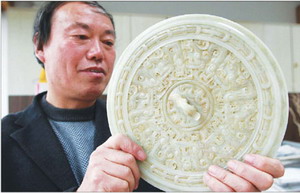Delicacies
Stuffed with goodness
By Ma Lie (China Daily)
Updated: 2011-04-07 12:10
 |
Large Medium Small |
 |
|
Golden-fish-shaped dumplings served at a banquet in Xi'an, Shaanxi province. Provided to China Daily |
The ubiquitous dumpling can also form the basis of a veritable feast.
Xi'an
Whether you are traveling in the north or the south of China, one delicacy you are almost sure to find on the menu is jiaozi, ear-shaped dough dumplings with various fillings.
But the dumplings served up in large restaurants in Xi'an, capital of Shanxi province in northwest China as part of the area's famous dumpling banquet will surprise you for being far different from the common dish eaten at home or in other cities.
As a universally popular dish, the Chinese dumpling has a long history and is an essential part of celebratory meals such as those prepared for Spring Festival. The dumpling can be anything from a quick snack to a delicacy for entertaining family and friends, or form the basis of a veritable feast.
A well-loved story tells how during the Eastern Han Dynasty (25 - 200 AD) a doctor named Zhang Zhongjing traveled back to his hometown in the county of Nanyang and found the people there suffering from an outbreak of typhoid and dying from hunger and cold. The weather was so cold many had frostbitten ears. The kindly doctor set about concocting a mixture of mutton, cayenne and a special medicine that he wrapped in a piece of ear-shaped dough. The dumplings Zhang made were fed to the starving people and by New Year's Eve, not only were they saved from the typhoid epidemic but their frost bitten ears were also healed. The doctor's fame spread far and wide, and the dumpling became a favorite addition to the Chinese diet from then on.
Xi'an, an ancient city with a history of more than 2,000 years, served as the nation's capital during 13 dynasties spanning more than 1,000 years. It is regarded as the home if not the birthplace of the great dumpling tradition. It was here that the art of creating the most tasty and delicate of dumplings was refined and no visit to the city is complete unless you take part in a dumpling feast.
According to Li Changyou, researcher and deputy director of Shaanxi Food Culture Research Association, people in Chang'an (now Xi'an), capital of Western Han Dynasty (206 BC - 24 AD) liked very much to eat jiaozi and the delicacy was used to welcome guests.
Chefs in Xi'an inherited the tradition and developed a special dinner known as the dumpling banquet. It is an unusual experience for the dumpling connoisseur as the dumplings are made with different flavors, shapes and colors, and the elegant names and stories attached to each variety are truly amazing. It is no less amazing that a simple way of preparing food has become so popular and sophisticated, with the feast now considered as much a work of art as a tasty morsel.
Dumplings have also changed in style, color and taste.
Chefs making the dumpling banquet have ventured from the tradition of using pork, beef, mutton and vegetable as the filling to making mixed fillings with chicken, duck, fish and egg as well as other delicacies from land and sea. Cooking methods have also expanded from boiling and steaming to frying and grilling.
Chefs also try out different tastes such as sour, sweet and peppery.
People who have tasted a Xi'an dumpling banquet have had deep impressions from the experience, not only because of its beautiful styles and delicious taste, but also because it includes many cultural connotations.
For example, a baochuan steamed dumpling made with pork filling comes from a legend of Wang Baochuan, a kind-hearted and faithful wife who waited for her husband for 18 years after he left for war.
The black rice steamed dumpling, with black rice as its filling, draws its name from a legend about Zhang Qian, an explorer, traveler and diplomat in the Western Han Dynasty who made great contributions to open up the ancient Silk Road linking China and Europe and who reputedly found black rice. The last dish of the dumpling banquet is a chrysanthemum dish, in which pearl-shaped dumplings the size of fingertips are boiled in front of the guests before being served. When guests taste the dumplings they are said to receive blessings according to the number of the treats they eat.









